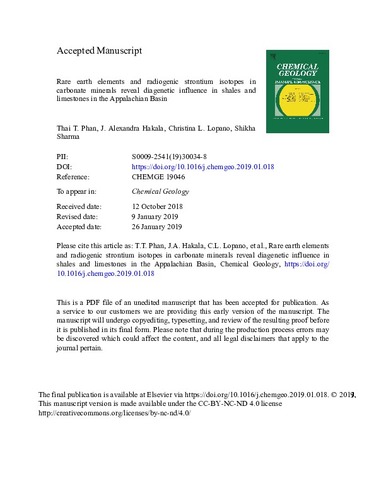| dc.contributor.author | Phan, Thai | |
| dc.contributor.author | Hakala, J. Alexandra | |
| dc.contributor.author | Lopano, Christina L. | |
| dc.contributor.author | Sharma, Shikha | |
| dc.date.accessioned | 2020-02-05 21:00:55 (GMT) | |
| dc.date.available | 2020-02-05 21:00:55 (GMT) | |
| dc.date.issued | 2019-03-30 | |
| dc.identifier.uri | https://doi.org/10.1016/j.chemgeo.2019.01.018 | |
| dc.identifier.uri | http://hdl.handle.net/10012/15620 | |
| dc.description | The final publication is available at Elsevier via https://doi.org/10.1016/j.chemgeo.2019.01.018. © 2019. This manuscript version is made available under the CC-BY-NC-ND 4.0 license http://creativecommons.org/licenses/by-nc-nd/4.0/ | en |
| dc.description.abstract | Rare earth element (REE) signatures are often applied to interpret paleoenvironmental conditions in sedimentary basins, however the complicated diagenetic histories in dynamic depositional environments can affect interpretation of measured REE signatures. Prior studies on REE content in shales and limestones indicated that REE in specific mineral phases may provide unique information concerning diagenetic reactions occurring in sedimentary rocks during burial and compaction. Application of sequential extraction techniques to target REE signatures in specific mineral fractions may provide greater insight into the complex processes that occurred during diagenesis and catagenesis. Thus, using this technique, this study provides a detailed account for REE, 87Sr/86Sr, and δ13C in the carbonate fraction of the Marcellus Shale and adjacent formations in the Appalachian Basin. A suite of 49 rock samples collected from two cores recovered from Monongalia County, West Virginia, USA was analyzed. The results showed that the carbonate concretions in calcareous shales and carbonate cements in black shales were very distinct. The REE plus yttrium (REY) were more concentrated in the carbonate concretions than in the carbonate cements. The carbonate concretions displayed REY patterns that are closely similar to modern seawater, while MREE-enrichment was observed in the carbonate cements. Likewise, the 87Sr/86Sr values in the carbonate concretions were similar to those measured for unaltered Middle Devonian carbonates, while the 87Sr/86Sr in the carbonate cements were much more radiogenic. This observation indicates that the carbonate cement could have been inherited radiogenic 87Sr expulsed from clays during illite-smectite transition. Overall, this study demonstrated two distinct processes involved with controlling the carbonate geochemistry within Appalachian Basin shales and limestones: one fraction displaying minimal diagenetic alteration relative to depositional conditions (carbonate concretions in calcareous shales and limestone carbonate in limestones), and another fraction displaying the evidence for extensive chemical alteration during illite-smectite transition and catagenesis (carbonate cements in black shales). In addition, highly variable and significant enrichments of U and Mo demonstrate that the Union Spring member and the Lower Oatka Creek member of the Marcellus Shale in the southwestern Appalachian Basin (MSEEL site) were deposited under mainly anoxic environment whereas intermitted episodes of dysoxic to perhaps oxic conditions occurred during the deposition of the Upper Oatka Creek member. | en |
| dc.description.sponsorship | This study was supported by the U.S. Department of Energy, Office of Fossil Energy, as the National Energy Technology Laboratory's ongoing research. Samples for this research were provided by the Marcellus Shale Energy and Environment Laboratory (MSEEL) funded by Department of Energy's National Energy Technology Laboratory (DOE-NETL) grant DE# FE0024297. | en |
| dc.language.iso | en | en |
| dc.publisher | Elsevier | en |
| dc.rights | Attribution-NonCommercial-NoDerivatives 4.0 International | * |
| dc.rights.uri | http://creativecommons.org/licenses/by-nc-nd/4.0/ | * |
| dc.subject | rare earth elements | en |
| dc.subject | diagenesis | en |
| dc.subject | paleoenvironment | en |
| dc.subject | carbonates | en |
| dc.subject | middle REE enrichment | en |
| dc.subject | sequential extractions | en |
| dc.subject | black shales | en |
| dc.subject | Marcellus Shale | en |
| dc.subject | illite-smectite transition | en |
| dc.subject | radiogenic strontium isotopes | en |
| dc.title | Rare earth elements and radiogenic strontium isotopes in carbonate minerals reveal diagenetic influence in shales and limestones in the Appalachian Basin | en |
| dc.type | Article | en |
| dcterms.bibliographicCitation | T.T. Phan, J.A. Hakala, C.L. Lopano, et al., Rare earth elements and radiogenic strontium isotopes in carbonate minerals reveal diagenetic influence in shales and limestones in the Appalachian Basin, Chemical Geology, https://doi.org/10.1016/j.chemgeo.2019.01.018 | en |
| uws.contributor.affiliation1 | Faculty of Science | en |
| uws.contributor.affiliation2 | Earth and Environmental Sciences | en |
| uws.typeOfResource | Text | en |
| uws.peerReviewStatus | Reviewed | en |
| uws.scholarLevel | Faculty | en |


